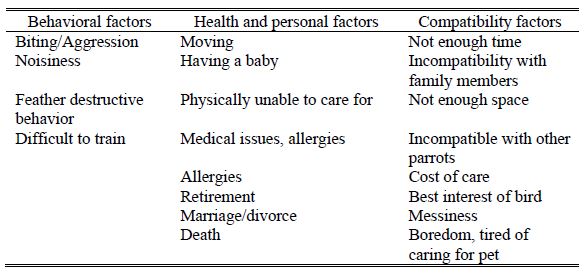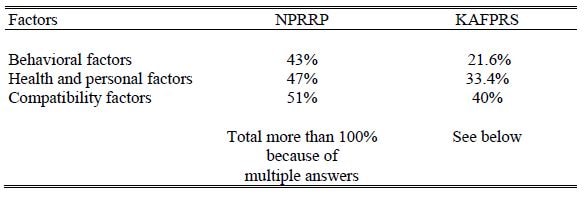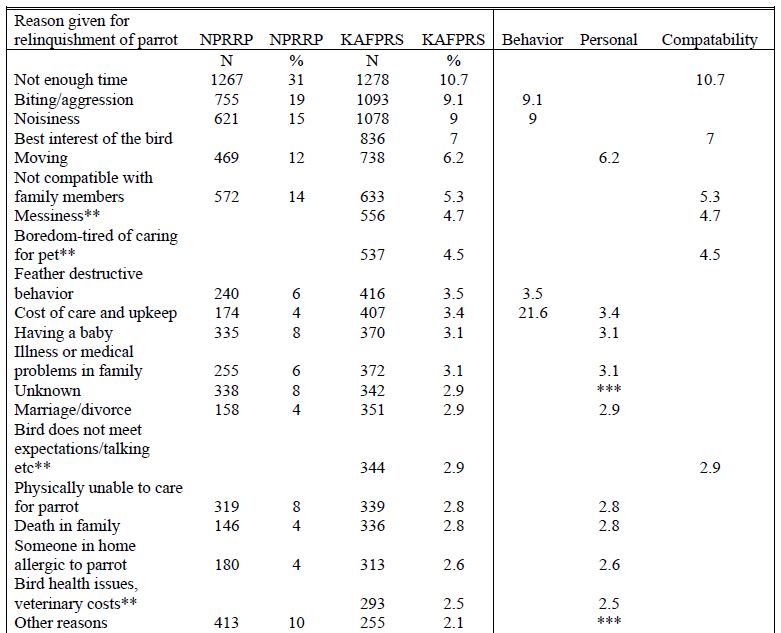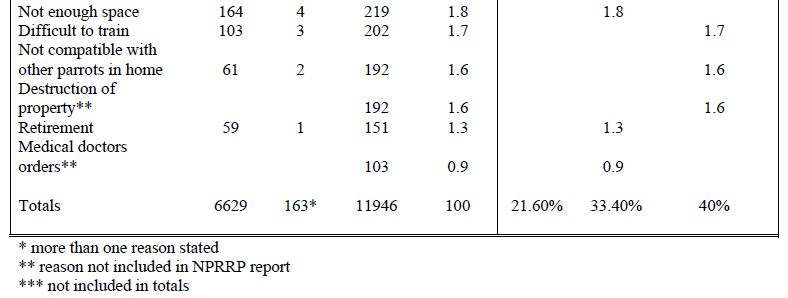Susan Clubb DVM, Dipl ABVP (Avian) and Michelle Goodman
Session #1665
Affiliation: From the Rainforest Clinic for Birds and Exotics, Inc, 3319 E Rd, Loxahatchee, FL 33470, USA (Clubb) and the Kaytee Learning Center, 521 Clay St, Chilton, WI 53014, USA (Goodman).
Introduction
The human fascination with parrots dates back to the time of Alexander the Great (4th century AD). For centuries parrots were rare in captivity and limited primarily to wealthy collectors. However large scale importation of parrots from the early 1970s until 1992 made parrots common and available to the masses in the United States as well as developed countries worldwide. The passage of the Wild Bird Conservation Act of 1992 halted the importation of most parrots into the United States and heralded an era of captive breeding in the US. American aviculture geared up to fill the demand for companion parrots.
It was soon apparent that America’s upwardly mobile society was often in conflict with the longevity of parrots resulting in the displacement of many parrots from their homes. Parrot welfare organizations, societies and rescue organizations were established to take in birds which were relinquished. The numbers of birds being relinquished became a subject for debate as are the reasons for relinquishment.
In 2008, the Kaytee Avian Foundation (KAF) established as a goal–to become an industry leader in the develop- ment of programs to increase the satisfaction of pet bird ownership. In order to fulfill that goal we embarked on a project to determine why parrots were being relinquished and where they were going. Many birds lose their homes due to changes in the family structure such as deaths, divorces, financial difficulties, moving into places that do not accommodate pets, etc. However, many also lose their homes because of unfulfilled expectations, becoming bored with the pet, and behavioral problems. The goal of KAF is to develop programs to address those issues which may be corrected, making each bird a valued and loved member of the family.
A model for this survey was the National Parrot Relinquishment Research Project (NPRRP) conducted in 2004 by the Gabriel Foundation and PetsMart Charities, and prepared by Cheryl Meehan, Ph.D. This survey was undertaken because of “increased public attention directed toward issues surrounding parrot ownership and relinquishment.” The Kaytee Avian Foundation developed a follow-up survey on similar themes. Most of the questions in the KAF relinquishment survey were similar, or identical to questions in the NPRRP survey. This was intended so that trends in relinquishment could be established over the 6-year period.
The KAF Parrot Relinquishment (KAFPR) survey was an online survey conducted between June 20 to August 30 of 2010 utilizing www.surveymonkey.com. Announcements were circulated utilizing many e-mail list serves targeting many stakeholders including avian welfare, sanctuary and rescue organizations, breeders, zoos, vet- erinarians and individuals who take part in accepting relinquished birds and ultimately rehoming or providing sanctuary for them.
Similar trends in parrot ownership were also happening in developed countries worldwide, although variations in wildlife laws resulted in variations in availability of birds, and hence relinquishment. While this study was designed as a survey on relinquishment in the United States, many responses were from outside the US.
Materials and Methods
Because of the very large dataset and page restriction, the entire survey cannot be presented in these proceed- ings. To access all of the data, please visit www.kaytee.com/assets/016/30210.pdf. If this link doesn’t work, go to Kaytee.com, click on Avian Foundation, then recent projects.
The survey was conducted completely online utilizing the survey software of surveymonkey.com. Survey ques- tions were presented to respondents as multiple choice questions–is presented in Appendix 1 of the survey on the website. Participants were notified by posting of announcements on various list serves which target hob- byists, rescue/sanctuary organizations, breeders, veterinarians, etc. Requests were made to widely cross post the announcements to any potentially interested audiences. Invitation letters are presented in Appendix 2 of the survey on the website.
Participation was “incentivized” by holding a sweepstakes in which the name of participant organizations were placed in a sweepstakes in which 20 participants were chosen to receive $1500 worth of Kaytee/Superpets products of their choice.
Results of the survey were reported from Survey Monkey in Excel format. These data were formatted into graphs and charts again utilizing Excel software.
Brief Results
The KAFPRS had a total of 1666 respondents as opposed to a total of 779 respondents for the NPRRP. In both surveys the majority of respondents were individuals with 40% of the respondents in KPRS and 58% of respon- dents in the NPRRP being individuals. The second largest group of respondents in the NPRRP was parrot welfare organizations (10.9%) while in the KPRS the second largest group was aviculturists (11.8%).
Most of the respondents who practiced referral of relinquished parrots, referred them to new homes, temporary shelters or in some cases breeders, with 23% being referred to permanent sanctuaries.
The location of respondents was very similar to the NPRRP report with highest numbers of respondents in states where typically the largest concentrations of breeders and pet bird owners are found–California, Texas, and Florida. However this was an international effort with responses also from 16 countries–a truly worldwide response. Interestingly, Australia had the highest level of response outside of the United States.
Conclusion (as It Appears in the Online Version)
Survey-based research projects are a frequently used tool for collecting data on companion animal population dynamics. Such projects can shed light on issues of importance relating to pet ownership and the human animal bond. Conservative interpretation of these data is essential as they are based only upon the respondents who are self selected via internet participation. Care should be taken to avoid extrapolation beyond the boundaries of this survey. Limitations of this survey were locating those organizations and individuals who are involved in care of relinquished parrots. A more expansive response could yield significantly different results.
The total population of parrots in the United States, much less total numbers of relinquished parrots, cannot be precisely determined using an internet survey. We attempted in this study to cast a wide net and reach out to large numbers of people involved in all aspects of parrot relinquishment.
According to responses to the survey, parrot relinquishment in the United States is predominantly done by individuals and families. Similarly, the recipients of a majority of relinquishments appear to be individuals or small organizations. And it is also very clear from conversations with the public that many transfers take place between individuals, family members and friends without involvement of a third party.
Alow percentage of respondents answered questions regarding structure of their organizations (typically, 250–270 individuals, or approximately 16%). It might be assumed that these questions were answered predominately by the larger organizations with more formal structure. However these questions did shed light on the diversity of organizations involved in relinquishment.
The summary section of the NPRRP stated that a total of 1959 birds were available for adoption at that time. The equivalent number in the KAFPRS was only 649. Might this indicate that organizations are more efficiently rehoming birds, or moving them to permanent housing in a sanctuary? Similarly the total number of relinquished birds in the NPRRP survey was 6629 compared to 11,946 in the KAFPRS which would constitute a large increase in relinquishments if the survey participants were comparable. With many more participants in the KAFPRS, this increase may not be significant, especially since a large number of participants were located outside the US. In fact comparison of these numbers may be inaccurate or misleading.
A key issue in the debate over parrot ownership and relinquishment is the ongoing question of parrot overpopu- lation. Many welfare and sanctuary organizations call foe an end to breeding parrots, concluding that the rate of production is outpacing the number of available homes. If the reduction in numbers of parrots available for adoption as reflected by the 2 surveys is in fact a true reflection of the current situation, it would certainly indicate that if the numbers of birds being relinquished is increasing; apparently the rehoming rate is also increasing and perhaps becoming much more effective or efficient in placement of birds needing a new home.
As in the NPRRP, a brief summary of the causes for parrot relinquishment may shed light on ways to reduce the impact of this problem (Tables 1 through 3). For this exercise we will again divide the causes of relinquishment into 3 broad categories: behavior factors; health and personal factors; and compatibility factors. These 17 reasons were discussed in the NPRRP as receiving at least 1% of responses.
Table 1. Factors behind parrot relinquishment include behavioral, health and personal, and compatibility issues.
Table 2. Factors cited for relinquishment of parrots in 2 studies. NPRRP signifies National Parrot Relinquishment Research Project and KAFPRS signifies KAF Parrot Relinquishment study.
Result in the KAFPRS survey were very similar, reflecting combined behavioral and compatibility issues as outweighing personal/health issues for relinquishment. These are areas where intervention may result in resolution of the problem.
Table 3. Breakdown on reasons for relinquishment in 2 studies: National Parrot Relinquishment Research Project (NPRRP) and KAF Parrot Relinquishment study (KAFPRS). N = number, % = percentage of respondents citing given reason.
Our focus as we move on and try to apply what we have learned is to examine those issues where we might, through education and behavior modification, enhance the human-animal bond or correct behavioral issues that are causing dissolution of that bond. Most of these aspects might be resolved with education of the owner and/ or positive reinforcement behavior modification for the bird, which also requires education of the owner.
The number one reason for relinquishment, “Not enough time,” may be valid in our society and these economic times, where people are overextended and distracted by many other possibilities. However, it is probably more of a reflection of dissatisfaction with the relationship, unfulfilled expectations, or boredom with the parrot because of the inability of the owner to communicate to the parrot their wants and needs. Unfulfilled needs of the parrot as well result in misbehavior that further weakens the bond. Many incompatibility issues, as well as behavioral issues such as aggression, noisiness, and to some extent feather destructive behavior, may be at least partially if not completely resolved by training and enrichment.
Probably the more difficult aspect of solving these problems is finding a way to reach the parrot owner before they have arrived at the decision to relinquish, so that intervention, education and training can occur.
Another important but difficult group to reach is the prospective parrot owner, shopping for their first bird. Education of this group so that they choose an appropriate bird for their family and go into the relationship with reasonable expectations might prevent many relinquishments. While educational material is available on the Kaytee website as well as many other internet resources, utilization of those resources may not be adequate. Many purchases are impulse buys and prospective owners may not take time to research the behavioral aspects and needs of a species prior to purchase.
Encouraging the sources of parrots: pet stores, breeders, etc to properly inform and educate prospective buy- ers is a critical component of creating a strong and durable bond. Such programs may be extremely beneficial in getting birds off to a good start in their new home with a family which is educated, and understands how to mold the behavior of their parrot so that they can not only peacefully co-exist, but also experience the joys of owning a well-behaved, happy parrot.
Acknowledgments: The authors thanks Kaytee Avian Foundation; Kaytee Products Inc for sponsorship of Sweepstakes rewards, without which this project would not have been possible; John Salm, Kaytee Learning Center; Melissa Mrotek, for preparation of graphs and charts from excel data; and Julie Murad, Director, Gabriel Foundation for assistance in developing questions.




